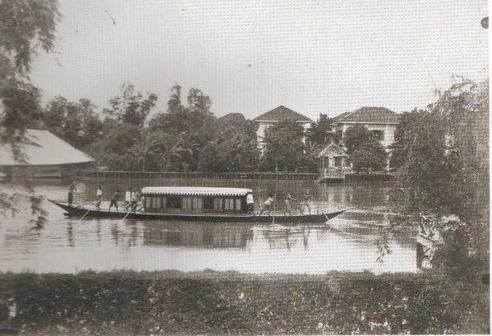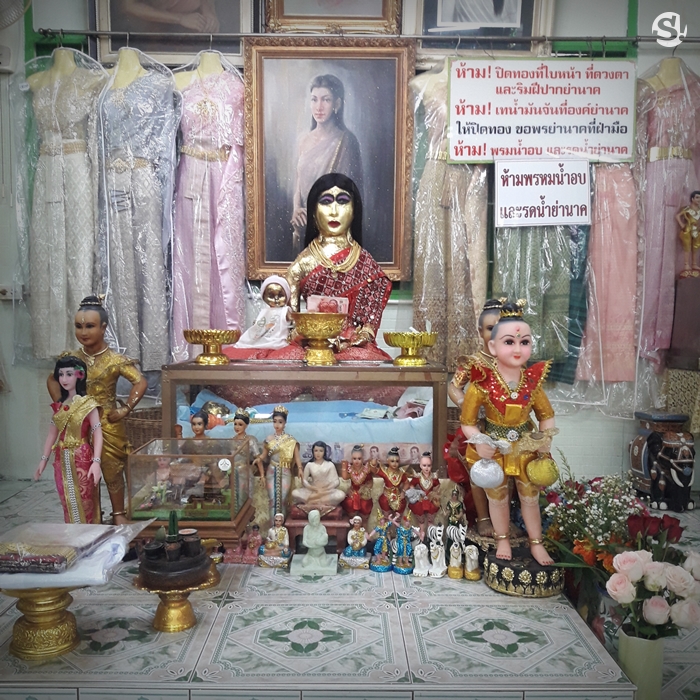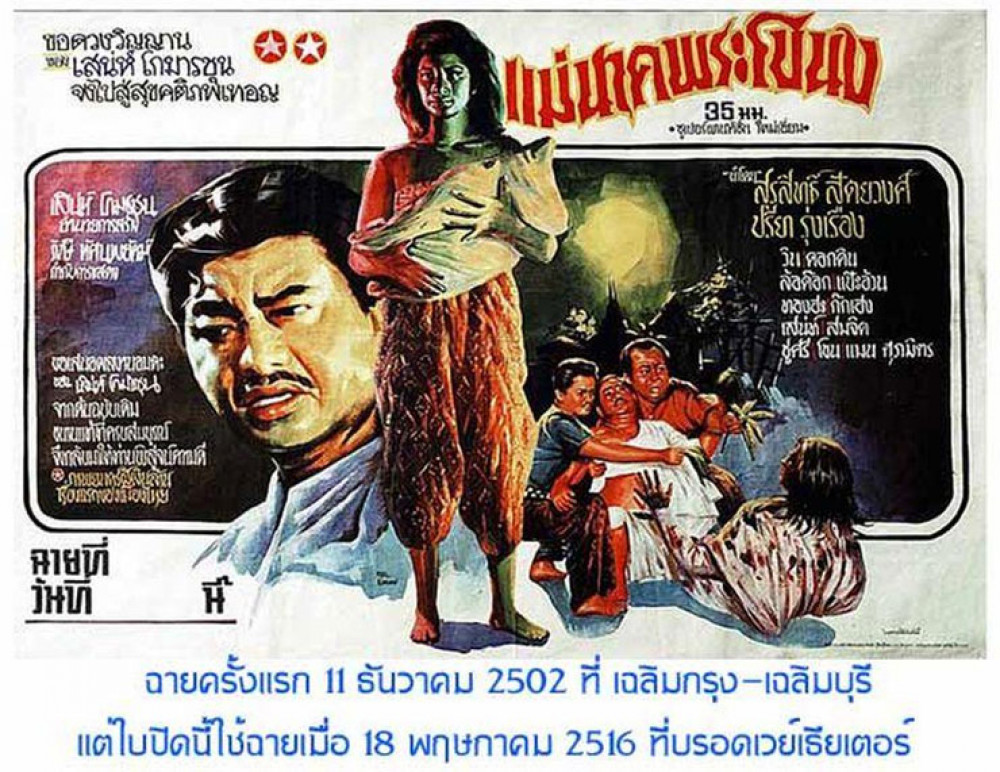Mae Nak Phra Khanong: Thailand’s Most Famous Ghost (Love) Story

[cr. Post Today]
Mae Nak Phra Khanong (แม่นาคพระโขนง) is among the best-known ghost stories in Thailand. A tale repeatedly told through various media, the legend of Mae Nak Phra Khanong strikes a chord with people to its universal theme of love and heartbreak.
Believed to date back to the early Rattanakosin period (around the 18th century), the legend has it that Mae Nak (“Mae” was used for “Miss” in those days) lived in the area near Wat Mahabut along a canal. Today that area is known as Soi Sukhumvit 77 in Bangkok’s Phra Khanong district and is home to her shrine.
Lost Love, a Vengeful Ghost, and Buddhism
According to the fable, Nak’s husband Mak was conscripted and sent to war while she was pregnant. Nak died during child birth, making her a “Pee tai tang klom” (ghost of a woman who died during childbirth with the baby still inside her). Her body was buried in the cemetery at Wat Mahabut. But because of love, Nak’s spirit was bound to her former life, re-appearing in human form to carry on daily chores at home. Every day she lingered on, waiting for her husband’s return. The terrified villagers invited monks and exorcists to banish her, but none succeeded.
After being treated for the wounds he sustained at war, Mak came back to Phra Khanong. At home, he was greeted by his loving wife, now with a newborn. Mak was finally living happily ever after with his wife and child, or so he thought.
 Phra Khanong in the past [cr.ย้อนรอยประวัติศาสตร์ยุคใหม่ในสยาม]
Phra Khanong in the past [cr.ย้อนรอยประวัติศาสตร์ยุคใหม่ในสยาม]
It was not long before the villagers revealed the truth to Mak: Nak and her child were in fact dead. Mak was furious and dismissed the warnings as rumors. One day while cooking, Nak accidentally dropped a lime from her porch. Reaching for the lime, she stretched her inhuman arm all the way from the second-floor balcony down to the grounds below. At that very moment, Mak returned home from running errands to witness the horrifying scene. He became so horrified that he fled to the nearby temple. Heartbroken and furious, Mae Nak set out on a spree of revenge, terrorizing people in the community for causing Mak to leave her.
Eventually, the revered monk Somdej Phra Buddhacarya, also known as Somdej Toh, came to the people’s aid. He approached Nak’s spirit with calmness and pure compassion. With Somdej Toh’s guidance, Nak was able to let go of her past life and move on. The venerable father then cremated Nak’s body and carved out a piece of her forehead bone to keep as an amulet. The bone has since become a lost treasure with legendary status among Thai amulet collectors.
Today, people from all walks of life travel to the Mae Nak’s shrine at Wat Mahabut to pay their respect and seek her favors. She is particularly popular among those hoping not to be picked for military service in Thailand’s lucky draw-style conscription.

Mae Nak’s statue at Wat Mahabut [cr. Sanook]
Mae Nak Phra Khanong is a touching love story with colorful characters, powerful emotions, and a tragic undertone. It stands out from other tales of horror; whose narratives offer only gore and excitement.
Mae Nak’s tale is sorrowful and heartbreaking. It portrays how love can bring about great happiness, and how the end of love can bring about great sorrow. Nak’s love and devotion was powerful, even allowing for her to rise from death. Yet, when the truth is revealed, her power of love became a power of destruction.
The story also serves as an illustration of Buddhist teachings, namely samsara (the unavoidable cycle of birth, aging, sickness, and death) and the Three Marks of Existence – anicca (all things are impermanent), dukkha (life is full of suffering), and anatta (there is no such thing as an immortal, non-changing self). In the end, nothing can triumph over truth, not even love.
Mae Nak in Popular Culture
The tale of Mae Nak has a special place in Thai society. Mae Nak’s ghost has been immortalized through story-telling, folk songs, and art. Many people still believe in the authenticity of the legend, which is why worshippers still flock to the shrine at Mahabut temple.
The story of Mae Nak Phra Khanong is also a popular subject for films, television series, and musicals. There are many versions of Mae Nak, with the first film made in 1936 by M.R. Anusakdi Hassadinthorn. In 1959, Sanae Komarachun’s version saw Mae Nak depicted as a possessive ghost that haunts people. Like Komarachun’s work, most of the early portrayals focused on her ghostly life and how she terrified people in the Phra Khanong area.

Sanae Komarachun’s Mae Nak Phra Khanong [cr. Post Today]
The tale of Mae Nak took an interesting twist when acclaimed director Nonzee Nimitbutr chose to highlight the element of romance instead of the horror in his 199 film Nang Nak. The new romantic approach continued in later incarnations including Mae Nak The Musical by DreamBox Theatre and Mae Nak Phra Khanong The Musical by Takolkiat Veeravan.
In 2012, Mae Nak 3D was released. It was a period film that added another part of the story and showed Mak seeking treatment for his wounds with Somdej Toh. In 2013, the Mae Nak story reached another milestone when local film company GDH (then GTH) made a movie based on Nak’s story but telling story it through Mak’s point of view. Directed by Banjong Pisanthanakun, the comedy-horror titled Pee Mak became a blockbuster, setting an all-time record for Mae Nak films and grossing more than 1 billion baht. In addition, the movie was shown around the globe, making the famous Thai ghost even more popular among foreigners.

Pee Mak [cr. Siamzone]
Truth or Fable?
Leading Thai history writer K.S.R. Kularb wrote an article in the Siam Praphet newspaper on March 10, 1899 in which he claimed that the story of Mae Nak was based on the life of Amdaeng Nak (“Amdaeng” means “Mrs”), a daughter of a community leader in Phra Khanong named Khun Si. Amdaeng Nak died while she was pregnant. Her son, worried that his father might remarry and cause him to lose a portion of his inheritance, invented the ghost story. He dressed in woman’s clothing and threw rocks at passing boats to make people think Nak’s ghost was responsible, causing possible suitors to turn away in fear. Kularb also suggested that Nak’s husband was named Chum, not Mak , The events, according to K.S.R Kularb, took place during the reign of King Rama III (1824-1851) If this article is to be believed, then Mae Nak is real and the ghost is fake.
One theory about Mak’s name has it coming from the lyrics written by Prince Narathip Praphanpong (1861-1931), son of King Mongkut the Great, for the Thai-style operatic drama E-Nak Phra Kha Nong in 1911 during the reign of King Rama VI (1910-1925). The Prince created Mak as a male character who dreamt about Nak and their past together.
Mae Nak is also mentioned in the epic poem Khun Chang Khun Phaen where is it implied that Mae Nak’s foetus is used for black magic. The sorcerer obtained a foetus for the ritual and it was revealed that it was a boy from Mae Nak’s womb.
We may never know whether the tale of Mae Nak Phra Khanong is based on a true story or not, but one thing is certain: nothing will ever stop the fondness Thais have for this love/horror tale.
***************************
References
Nawikkamun, Anek. Mae Nak Prakanong Young Mai Tai [Mae Nak Prakanong lives]. Watthanatham Journal: Department of Cultural Promotion, vol. 51, no. 2, July-September 2012, p. 36-43. Available at http://magazine.culture.go.th/2012/2/files/assets/basic-html/index.html#page38.
“Mae” Nai Bo Ri Bod Mo Ra Dok Bhumi Pun Ya Tarng Wat Ta Na Tham [The intangible cultural context of “Mom”]. Intangible Cultural Heritage. Available at http://ich.culture.go.th/index.php/en/articles/770-meenak.
Tum Narn Mae Nak Pra Ka Nong [The legend of Mae Nak Prakanong]. Intangible Cultural Heritage. Available at http://ich.culture.go.th/index.php/th/ich/folk-literature/252-folk/111—–m-s.
Bunnag, Rome. Perd Tum Narn “Mae Nak Pra Ka Nong” Phee Tee Mai Koey Lork Krai Chuei Khon Hai Ruey Gun Tuen Nah Look Look Sa Ra Parb Aeng Pen Khon Lork Khon!! [Truth Be Told: Mae Nak Pra Ka Nong is actually helping people increase their fortunes, not scaring them away as many have claimed!!] MGR Online, 20 November 2017. Available at “https://mgronline.com/onlinesection/detail/9600000117051.
Meenanon, Kao. Yorn Way La Hok Phee Phee Mark Pra Ka Nong Pra Kot Ta Karn Tum Ngern Pun Larn! Lae Nung Thai Tum Ngern Soong Sood [Phee Mark Pra Ka Nong: The phenomenon of Thai cinema]. The Standard, 28 March 2018. Available at https://thestandard.co/5-years-pee-mak/.


